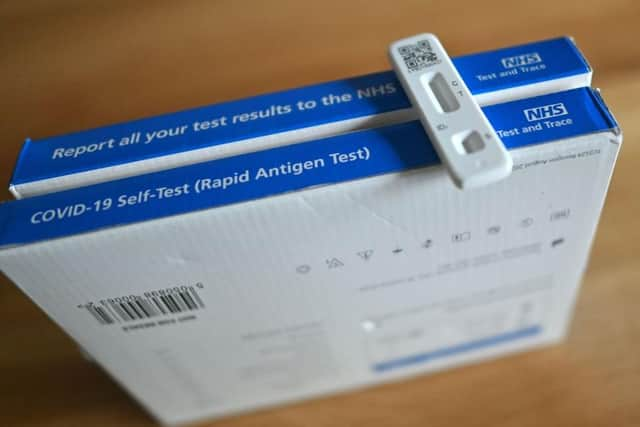Covid-19: Almost 10% of some parts of London test positive amid record infection rates
and live on Freeview channel 276
One in 11 people in some London boroughs have Covid-19, as rates of infection hit record highs across the country, new data has revealed.
Coronavirus rates have been rocketing in recent weeks, as the spread of the virus has reached its highest ever level in the UK since the start of the pandemic.
Advertisement
Hide AdAdvertisement
Hide AdAcross the capital, a total of one in every 13 Londoners - or 7.7% of the city - is infected with Covid-19, according to data from the Office for National Statistics (ONS), as of March 23.


While in some boroughs the rate is one in 11, or 9.09% of the area.
It comes as the number of people infected has hit an all-time record for England and Wales.
While Scotland is at a near-record high and infection levels are also high in Northern Ireland.
Advertisement
Hide AdAdvertisement
Hide AdHounslow, Newham, Southwark and Wandsworth are recording Covid-19 rates of one in 11, the ONS found, as of March 20 to 26.
Loading....
In Camden, Greenwich, Harrow, Havering, Kingston upon Thames, Merton, Richmond upon Thames and Waltham Forest, rates are at one in 12.
While in Barking and Dagenham, Bexley, Croydon, Enfield, Lambeth, Lewisham, Sutton and Tower Hamlets, one in every 13 residents are testing positive.
Barnet, City of London, Hackney, Islington, Hammersmith and Fulham, Kensington and Chelsea, Westminster, Hillingdon and Redbridge are recording one in 14 positive tests.
Advertisement
Hide AdAdvertisement
Hide AdIn Brent, rates are at one in 15, compared to one in 16 in Ealing and Haringey, and one in 17 in Bromley.
Loading....
Newham has the highest rate in the city, with 8.9% of residents testing positive, while Bromley is the lowest with just 5.8%.
The random mass testing regime done by the ONS is more accurate than the government’s Covid case data, which relies on people doing tests and reporting their positive results.
The data published on Friday, April 1, shows the number of people infected in each local area of England, Scotland, Wales and Northern Ireland to March 26.
Advertisement
Hide AdAdvertisement
Hide AdRecord highs were recorded in the fortnight from March 12 to March 26 in the east Midlands, the southeast and the southwest.
And as of March 23, infection rates stood at one in 17 in the northeast; one in 14 in the northwest, Yorkshire and the Humber, the east Midlands and the west Midlands; one in 13 in the east of England and London; one in 12 in the southeast; and one in 11 in the southwest.
Professor Kevin Fenton, public health regional director for London, said: “One of our concerns in the city is levels of inequality in who is vaccinated and who is not vaccinated in London.
“We see differences in vaccination uptake by a range of characteristics, including ethnicity, age and social and economic deprivation. Some of the patterns are stark.
Advertisement
Hide AdAdvertisement
Hide Ad“If you live in more affluent parts of the city you’re far more likely to have had your Covid-19 vaccine than if you live in more deprived areas.”
Mayor Sadiq Khan has called for free testing, which ended on April 1, to remain in place, saying: “We can’t ‘live with Covid’ if we don’t know who has it.
“Covid testing keeps Londoners safe and helps get our city firing on all cylinders once again. It should be free to everyone who needs it.”
A UK health security agency (UKHSA) spokesperson said: “As we learn to live with Covid, we are encouraging people to keep following simple steps to help keep themselves and others safe.
Advertisement
Hide AdAdvertisement
Hide Ad“The pandemic is not over. Covid still poses a real risk to many of us, particularly with case rates and hospitalisations on the rise.
“That is why it is sensible to wear a mask in enclosed spaces, keep indoor spaces ventilated and stay away from others if you have any symptoms of a respiratory illness, including Covid.
“Vaccination remains the best way to protect us all from severe disease and hospitalisation due to Covid infection.
“If you have not yet come forward for your primary or booster jab you should do so straight away – the sooner you are vaccinated the sooner you and your family and friends will be protected.”
For more information, visit the government’s Covid-19 database website.
Comment Guidelines
National World encourages reader discussion on our stories. User feedback, insights and back-and-forth exchanges add a rich layer of context to reporting. Please review our Community Guidelines before commenting.